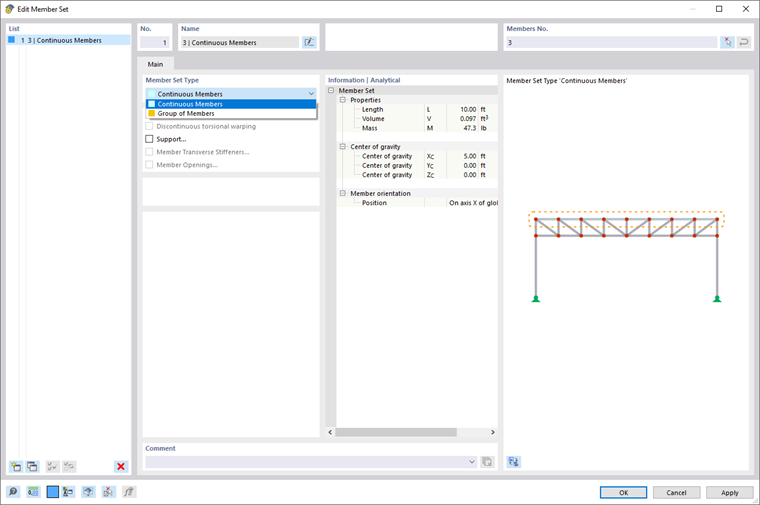All members are considered individually in the warping calculation, that is, each member can warp freely at its end. There is no transfer of the bimoment between adjacent members.
Continuous Warping
Define a member set to transfer the warping between individual members. For member sets of the “Continuous member” type, the warping between all connected members is assumed to be continuous. You can find information on creating member sets in the chapter Member Sets of the RFEM manual.
For member sets that do not exclusively contain members of the “Beam” type or where some members have a cross-section with deactivated warping stiffness, only the warping of the beam members among themselves is considered as continuous. At the ends of members that are calculated with 6 degrees of freedom, the warping is unrestricted.
Alternatively, members can be modeled without division. Intermediate nodes are created as “Nodes on member” and do not result in the division of the member into two objects. Such nodes on a member do not result in discontinuous warping. For more information, refer to the chapter Divide Line/Member of the RFEM manual.
Using the above options, you can define the transition conditions for the warping between two members. At a nodal point with more than two adjacent members, the warping can only be transferred between two members at a time.
Before the calculation, the plausibility check checks the compatibility of the cross-sections in member sets with regard to warping. Continuous warping between members is allowed without further warning messages under the following conditions:
- Continuous centroidal axis
- Same cross-section at the connected member ends
- Same coordinate system of members
Discontinuous Torsional Warping
If you do not want continuous warping for a defined member set, for example, because the member set only serves as a reference for the input, you can activate the “Discontinuous torsional warping” option in the editing dialog box of the member set. In this case, all members of the continuous member set are again considered to have unrestrained warping at their ends.
If a member is part of several member sets with different properties, the continuity of the warping between the members has priority. Within all member sets with the “Discontinuous warping torsion” option deactivated, the warping distribution is thus continuous, regardless of whether the members are still part of another member set with the activated “Discontinuous torsional warping” option.
